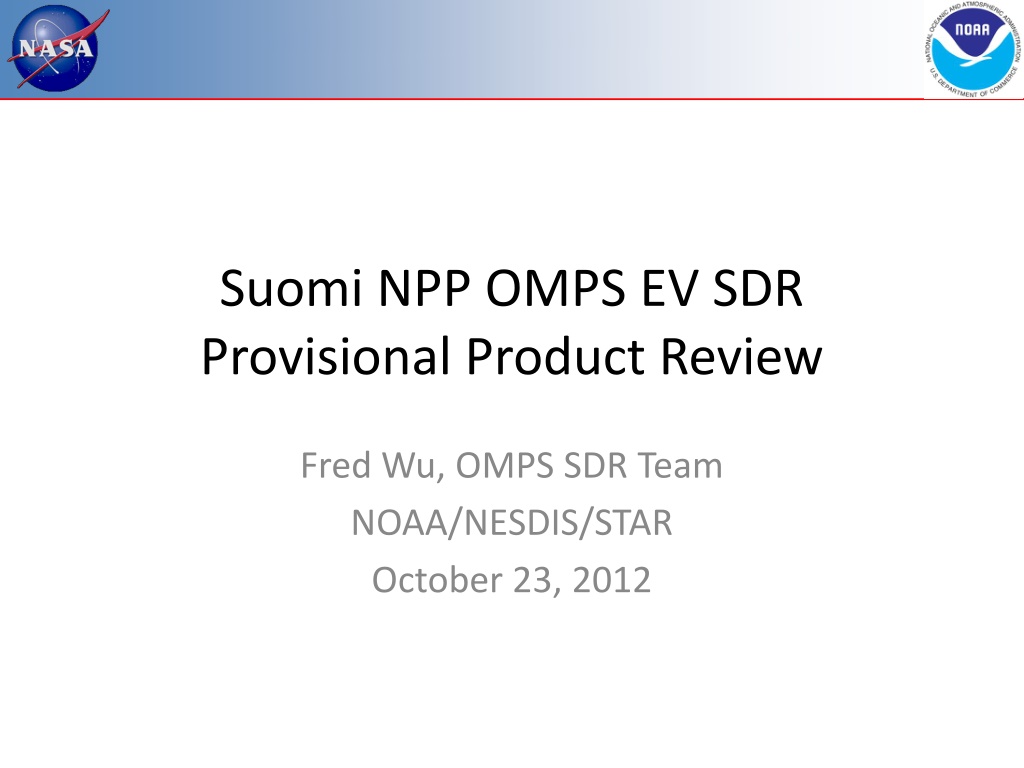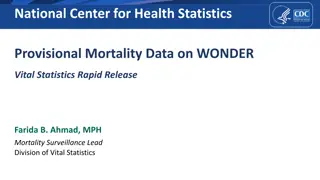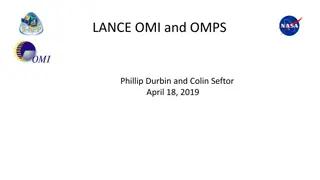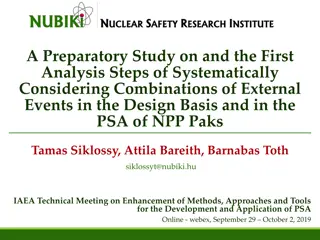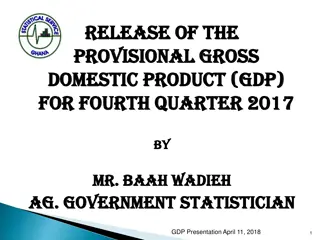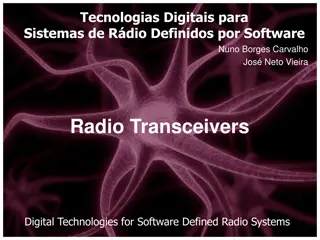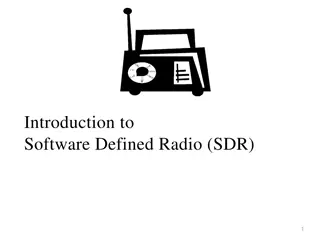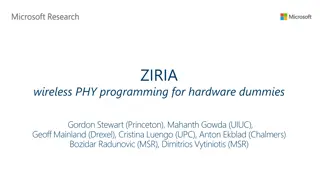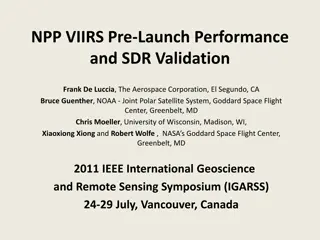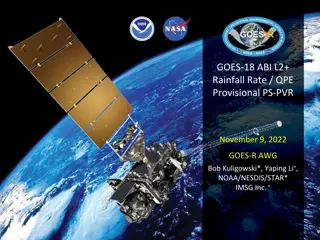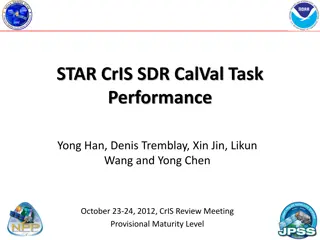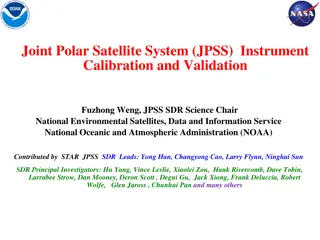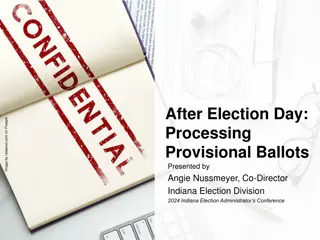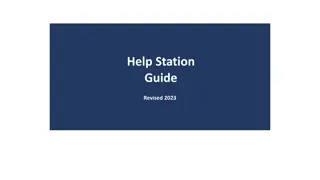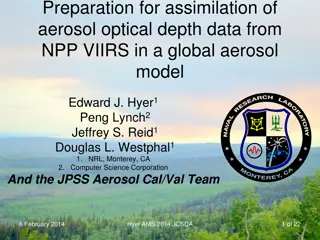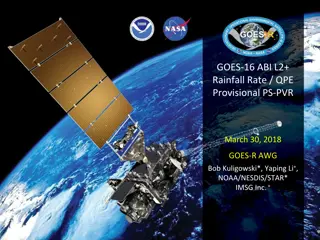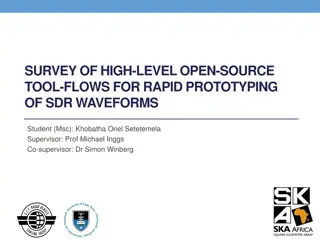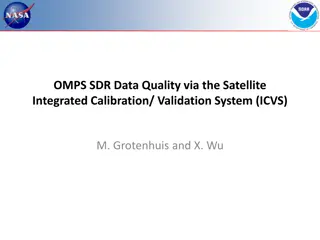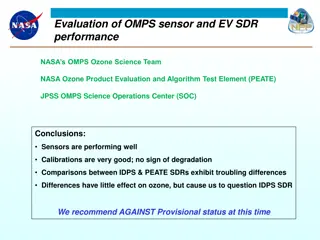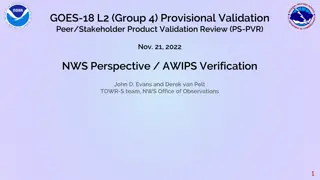Suomi NPP OMPS EV SDR Provisional Product Review
Review of the Suomi NPP OMPS EV SDR Provisional Product by Fred Wu and the OMPS SDR Team at NOAA/NESDIS/STAR on October 23, 2012. The product includes monitoring of ozone and other constituents using various instruments like Nadir Mapper, Nadir Profiler, and Limb Profiler. The operational evaluation criteria for the product's provisional maturity are described along with team members' roles, milestones, and progress towards achieving provisional status.
Download Presentation

Please find below an Image/Link to download the presentation.
The content on the website is provided AS IS for your information and personal use only. It may not be sold, licensed, or shared on other websites without obtaining consent from the author.If you encounter any issues during the download, it is possible that the publisher has removed the file from their server.
You are allowed to download the files provided on this website for personal or commercial use, subject to the condition that they are used lawfully. All files are the property of their respective owners.
The content on the website is provided AS IS for your information and personal use only. It may not be sold, licensed, or shared on other websites without obtaining consent from the author.
E N D
Presentation Transcript
Suomi NPP OMPS EV SDR Provisional Product Review Fred Wu, OMPS SDR Team NOAA/NESDIS/STAR October 23, 2012
OMPS Ozone Mapper Profiler Suite Global and daily monitoring of three dimensional distribution of ozone and other constituents Nadir Mapper Grating spectrometer, 2-D CCD 110 deg. cross track, 300 to 380 nm spectral, 1.1nm FWHM bandpass Nadir Profiler Grating spectrometer, 2-D CCD Nadir view, 250 km cross track, 270 to 310 nm spectral, 1.1 nm FWHM bandpass Limb Profiler L. Flynn 23 October 2012 NCWCP 2
OMPS Products IDPS produces 18 types of Data Record from OMPS nadir instruments: 9 RDRs 6 SDRs 2 Calibration SDR 2 Calibration SDR GEO 2 Earth View (Science) SDR focus of the review 2 EDRs and 1 IP 23 October 2012 NCWCP 3
Team Members Roles & Responsibilities Name Organization Task X. Wu NOAA/NESDIS/STAR SDR Team Lead L. Flynn NOAA/NESDIS/STAR EDR Team Lead G. Jaross SSAI Technical Lead S. Janz NASA/GSFC Instrument M. Caponi Aerospace Algorithm Manager N. Baker, M. Denning, T. Kashita, W. Thomas DPA/DPE DPA/DPE SDR Team Lead Support C. Pan UMD B. Sen, M. Novicki, W. Li NGAS Calval S. Miller, W. Johnsen, J. Cram, W. Ibrahim, M. Montgomery-Seaman, P. Smit, D. Stuhmer, N. Anderson, D. Cumpton, N. Emmert RTN/CGS Algorithm R. Buss RTN/O&S Data quality S. Lipscy, K. Brownsberg BATC Instrument 4
Milestones 2011-10-28: Launch 2012-01-27: Door open, 1st image 2012-03-12: Beta status for EV SDR (45 days after door open) 2013-03: Scheduled Provisional (15 months after launch) Now to review the status and identify the path to the goal 23 October 2012 NCWCP 5
http://ozoneaq.gsfc.nasa.gov/omps http://ozoneaq.gsfc.nasa.gov/omps Criteria for Provisional Maturity Provisional Product quality may not be optimal Incremental product improvements are still occurring as calibration parameters are adjusted Version control is in affect General research community is encouraged to participate in the QA Users are urged to consult the SDR product status documents prior to use of the data in publications Ready for operational evaluation 23 October 2012 NCWCP 6
Milestones Toward Provisional Instruments performance Version track and baseline SDR quantity (production) SDR quality (cal/val) 23 October 2012 NCWCP 7
Instrument Performance NM Requirement Specification/Prediction Value On-Orbit Performance Non-linearity < 2% full well < 0.46% Non-linearity Knowledge < 0.5% ~0.1% On-orbit Wavelength Calibration < 0.01 nm average ~0.01 nm RMS Stray Light NM 2 average ~ 2% Out-of-Band + Out-of-Field Response Intra-Orbit Wavelength Stability <0.02 nm < 0.013 nm SNR >1000 > 1000 from SV and EV Inter-Orbital Thermal Wavelength Shift <0.02 nm <0.013 nm CCD Read Noise <60 e RMS < 25 e RMS Detector Gain >46 ~42 Absolute Irradiance Calibration Accuracy < 7% 5% Absolute Radiance Calibration Accuracy < 8% < 5% NCWCP 8 23 October 2012 C. Pan
Instrument Performance NP Requirement Specification/Prediction Value On-Orbit Performance Non-linearity < 2% full well < 0.46% Non-linearity Knowledge < 0.5% ~0.1% On-orbit Wavelength Calibration < 0.01 nm Stray Light NM 2 average ~ 2% Out-of-Band + Out-of-Field Response Intra-Orbit Wavelength Stability <0.02 nm < 0.013 nm SNR >1000 > 1000 from SV and EV Inter-Orbital Thermal Wavelength Shift <0.02 nm <0.013 nm CCD Read Noise <60 e RMS < 25 e RMS Detector Gain >43 ~45 Absolute Irradiance Calibration Accuracy < 7% 1~10% , average: ~7% Absolute Radiance Calibration Accuracy < 8% < 5% 23 October 2012 NCWCP 9 C. Pan
Version Track and Baseline Software version follows IDPS Build number (currently Mx6.3). One code change was implemented successfully without impact on data Mx6.3, Aug 2012, severe CAL and EV SDR. Two calibration updates were implemented successfully with the expected impacts on data Day 1 solar, May 2012 Wavelength scale, June 2012 Operational status is tracked at the Satellite Operation Center (SOC, http://ozoneaq.gsfc.nasa.gov/omps). 23 October 2012 NCWCP 10
Percent of OMPS RDR correctly retrieved from CLASS to PEATE since launch TC EV TC CAL NP EV NP CAL 100.00 95.00 90.00 Percentage (%) 85.00 80.00 75.00 70.00 65.00 60.00 2011/11 2011/12 2012/01 2012/02 2012/03 2012/04 2012/05 2012/06 2012/07 2012/08 2012/09 Months Since Launch Most important to users. Not necessarily the only way to evaluate 23 October 2012 NCWCP 11 R. Mundakkara
OMPS Progress since Beta 1. Update the Darks 2. Update the Day 1 Solar 3. Update the wavelength scale 4. Optimize performance in SAA 5. Correct for stray light 6. Correct for errors in smear 7. Monitor nonlinearity 8. Enhance product in high resolution Completed Non-critical Critical to Provisional 23 October 2012 NCWCP 12
On-orbit Observed Solar Flux Solar Irradiance @OMPS Nadir Resolution NM and NM overlap region On-orbit Predicted Observed solar irradiance is within ~2% of predicted synthetic solar spectra: NM is on average 4% with small scale variations NP is less than 2% on average with several percent variations 13 C. Pan
On-orbit Linearity Performance Max. Nonlinearity % Left CCD Half Right CCD Half System Requirement 2% Max. Nonlinearity % Date Measurement GMT changed 3 times: Nov. 08 Mar. 09; May 29 June 06; July 4-current OMPS linearity is exceptionally stable 14 C. Pan
On-orbit Dark Current Performance Dark measurement is established by optimizing various diagnostic dark cal. activities 15 C. Pan
Wavelength Shifts from Ground to Orbit Ozone Channel Wavelength Shift Wavelength changed less than 0.16 nm from ground to orbit. 16 C. Pan
OMPS SNR Verification SNR Solar measurement SNR meets the system requirement of 1000 17 C. Pan
OMPS Geolocation This image shows the effective reflectivity for the 380-nm Channel for part of an orbit of small Field- of-View (5 KM X 10 KM at Nadir) made by the OMPS Nadir Mapper in a special diagnostic mode. The Qatar peninsula sticking into the Persian Gulf in the middle of the picture lies along the nadir view of the orbital track and gives a preliminary assurance of the geolocation at better the 5 KM. C. Seftor
OMPS Products are stable 19 L. Flynn & W. Yu
OMPS SDR-Related DR Status DR # Short Description Large error in TLE geo calculation 4951 4927 FT document 474-00181 need update 4914 OMPS TC and NP GEO 4907 TC needs Stray light correction DR Summary (YTD): 4906 Cal RDRs truncated NP and TC Darks need to be updated 4879 37 new SDR related DRs submitted 4823 The NP stray light needs to be corrected. 4818 Smears in error - Smears show negative and unexpected values 4799 Inconsistent structure between OAD and EV SDR 25 closed, including DRs submitted in previous years 4749 OMPS darks have negative values 4693 Cal SDR strategy study 4676 Radiance error associated with aggregation 19 SDR related DRs open, all have expected completion dates 4673 Correction for different linearity slope Tup for CCD2 4672 Linearity correction update for xml file 4671 OMPS Data quality threshold tables non existence for SDR Critical SDR DRs: 4 4627 Quantization introduced by linearity correction error - Cal SDR 4615 Transient filter issue 4602 Spatial pixel mismatch in Cal SDR 4536 Sample table to include extra pixel to monitor stray light 23 October 2012 NCWCP 20 M. Caponi
Milestones Toward Provisional Instruments performance Very good in general. A few evaluations to be completed. Version track and baseline Established SDR quantity (production) Reasonable, to be further evaluated separately SDR quality (cal/val) Subject to the resolution of 3 critical issues (4 DR s): Darks; Stray light; and Smear 23 October 2012 NCWCP 21
Lesson Learned from Suomi NPP OMPS Test IDPS early and fully OMPS has often been given lower priority that does have effects. Provide science support for IDPS consistently Transition to STAR Consider OMPS Special Needs Highly versatile, designed for flexible operations not common to other instruments Some metrics critical to other instruments may not be as important for OMPS Did not focus on critical needs such as flexibility. 22
OMPS SDR Path Forward Transition critical capability to STAR Enabling STAR to support IDPS Update Darks CCD degradation has not been accounted for since Feb. 29. Correct for error in smear Correct for stray light for both NM & NP 23
http://ozoneaq.gsfc.nasa.gov/omps http://ozoneaq.gsfc.nasa.gov/omps Criteria for Provisional Maturity Explanation for the Provisional Maturity Assessment Correct for errors in smears (DR 4818) Correct for stray light (DR 4823 & 4907) Provisional Product quality may not be optimal Incremental product improvements are still occurring as calibration parameters are adjusted Update Darks LUT to correct for CCD degradation (DR 4799 & 4879) Software version follows IDPS build number (currently MX 6.3). Operation status is tracked at the SOC (http://ozoneaq.gsfc.nasa.gov/omps). Available from CLASS since March 12, 2012. A Readme file will be provided with the Provisional Release, as did with Beta Release, that contains the known caveats ATBD is up to date and calibration uncertainty will meet the requirements. Version control is in affect General research community is encouraged to participate in the QA Users are urged to consult the SDR product status documents prior to use of the data in publications Ready for operational evaluation 23 October 2012 NCWCP 24
Summary OMPS instrument performance is excellent OMPS EV SDR from IDPS has not taken full advantages of that performance Recommend to resolve three critical issues before OMPS EV SDR becomes Provisional: Darks Smear Stray light 25
